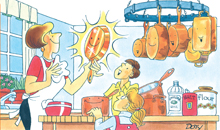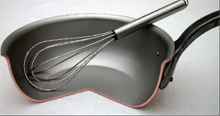The Serious Cook's Metal of Honor
 High-resolution version of this photo.
High-resolution version of this photo."There's an intense interest in culinary arts now," says John Milnthorp, business manager for the clad metals division of All-Clad Metalcrafters, which sells millions of dollars a year in copper cookware. The advent of an entire cable TV network, the Food Network, is certainly proof of the increased attention given to food preparation.
Along with this attention has come a substantial increase in copper cookware purchases. Copper provides the foundation for many gastronomic delights, including delicate sauces, candies and chocolate.
Copper's superior ability to conduct heat is an essential component of quality cookware. Used as an exterior base for pots and pans, copper is preferred by professional as well as amateur chefs who value its thermal properties. As a bonus, copper cookware offers the additional advantages of natural, aesthetic beauty and durability. Quick, uniform heat transfer across the bottom and sides of a pot or pan can make the difference between a light sauce and a lumpy paste. "The even distribution of heat cooks foods uniformly near the top of the pot as well as at its bottom - and it cooks them quickly, so there is minimal drying of moist foods," explains Cecile Lamalle in an article for The Cooks magazine.
"Copper is the best cooking equipment you can have," claims Henri Boubee, former corporate executive chef of Ritz-Carlton Hotels. "It heats uniformly, holds the heat best, and cooks the quickest."
Evenly distributed heat helps when preparing difficult dishes, such as crepes and delicate sauces like Béarnaise and hollandaise. With this and other sauces, if some parts of the pot are hot and other parts cool, continual stirring is required to even out the heat, otherwise the sauces separate or lose flavor. "But due to copper's fabulous thermal conductivity, you don't have to pay constant attention to the pot and you can still get a great sauce," says Milnthorp.
Copper pots are also excellent for sautéing and stir-frying.
COPPER'S "A NATURAL"
 A cross-section of a saucepan with a copper exterior. Copper's superior thermal conductivity makes it an ideal choice for cookware.
A cross-section of a saucepan with a copper exterior. Copper's superior thermal conductivity makes it an ideal choice for cookware.High-resolution version of this photo.
"There's also more interest in product durability and longevity. Copper is recyclable and renewable," says Herkes. Hammersmith makes copper cooking utensils by pouring the molten metal into a mold, then hand-wiping tin on the interior cooking surface. The company will reline the tin surface of the cookware when it wears down, typically, in about 15 years.
Copper must be lined with another substance - often tin or stainless steel - because copper may react with acidic foods, such as red sauces and citrus juices, resulting in potential food discoloration and intestinal malaise. Tin is a better heat conductor than stainless steel, but tin wears out over time and melts when subjected to high temperatures (425°F or higher) and has to be relined.
On the other hand, unlined copper is perfect for whipping up cream and egg whites and for the candy and confectionary industries that use sugary, nonacidic ingredients, according to Herkes. Chocolate, caramels, jams and jellies are stirred in huge, copper kettles that offer easy, precise temperature control.
Occasionally, Hammersmith will line copper with silver for "preferential chefs" who want the expensive lining for mixing bowls, such as for making zabaglione or Italian pastry.
Hammersmith also makes "hammered" copper cookware with small indents. "This hardens the metal and lets the heat travel even faster," he states. Hammersmith custom-designs utensils upon request, such as a sauté pan with taller sides.
A KITCHEN GEM
Beautification of the kitchen also drives the purchase of copper cookware. The bright glow of copper pots and pans adds panache to a room where, formerly, stylishness didn't count for much. "Their sheer beauty is very elegant - almost like jewelry for the kitchen," Milnthorp states. Copper's warm reflective shine is also the reason it is used for chafing dishes and food warmers - it imparts a sense of sophistication to food service.
All-Clad sells two copper cookware lines. The 20 year-old Cop-R-Chef line of pots, pans and skillets is clad with a copper exterior, lined with aluminum and has a stainless steel cooking surface. Because the copper is so beautiful, "some people buy a set, hang it in the kitchen and don't use it," says Milnthorp.
A newer line, Copper-Core, is comprised of stainless steel on the interior and exterior cooking surfaces, with a layer of copper in between. An aluminum layer seals the copper, preventing oxidation. A patented design peels away a ribbon of stainless steel, enabling a gleaming band of copper to shine through the exterior surface (see illustration). This line is popular because it is easy to clean while maintaining the conductive and aesthetically appealing advantages of copper.
Copper is generally purchased by those who are artisans in home and professional cooking. "People who are discerning use copper," states Milnthorp. Herkes adds, "Copper is the cook's Metal of Honor."
HISTORY
Cooking utensils have been made from copper for more than 3,000 years, since the Bronze Age, according to Jeffrey Herkes, owner of Hammersmith, which manufactures copper cookware in Brooklyn, New York. Aside from copper being a great heat conductor, our ancestors just didn't have much else to cook in, he adds.
Herkes recreated cookware used by American settlers for Colonial Williamsburg, the historical theme park in Virginia. During the 1760 to 1810 period, large copper pots were placed on the fire and left to heat all day, blending together all the ingredients for stews and casseroles. Until the Industrial Revolution, these utensils were made by rolling out a sheet of copper, hammering it into the shape of a pot over an anvil, and pouring a tin sheathing into it.
Because copper pots last so long and are a prized heirloom, Herkes has seen pots and pans 90 years old - some made long ago by his own company - come back to Hammersmith generations later to get retinned. "No one throws them away," he says. Cu
Resources:
Also in this Issue:
- The Serious Cook's Metal of Honor
- Keeping Copper Cookware Bright
- An Ancient Copper Treasure Map
- An Extension Cord to MARS
- The Scent of Cents
- Hiding Wires in Plain Sight
